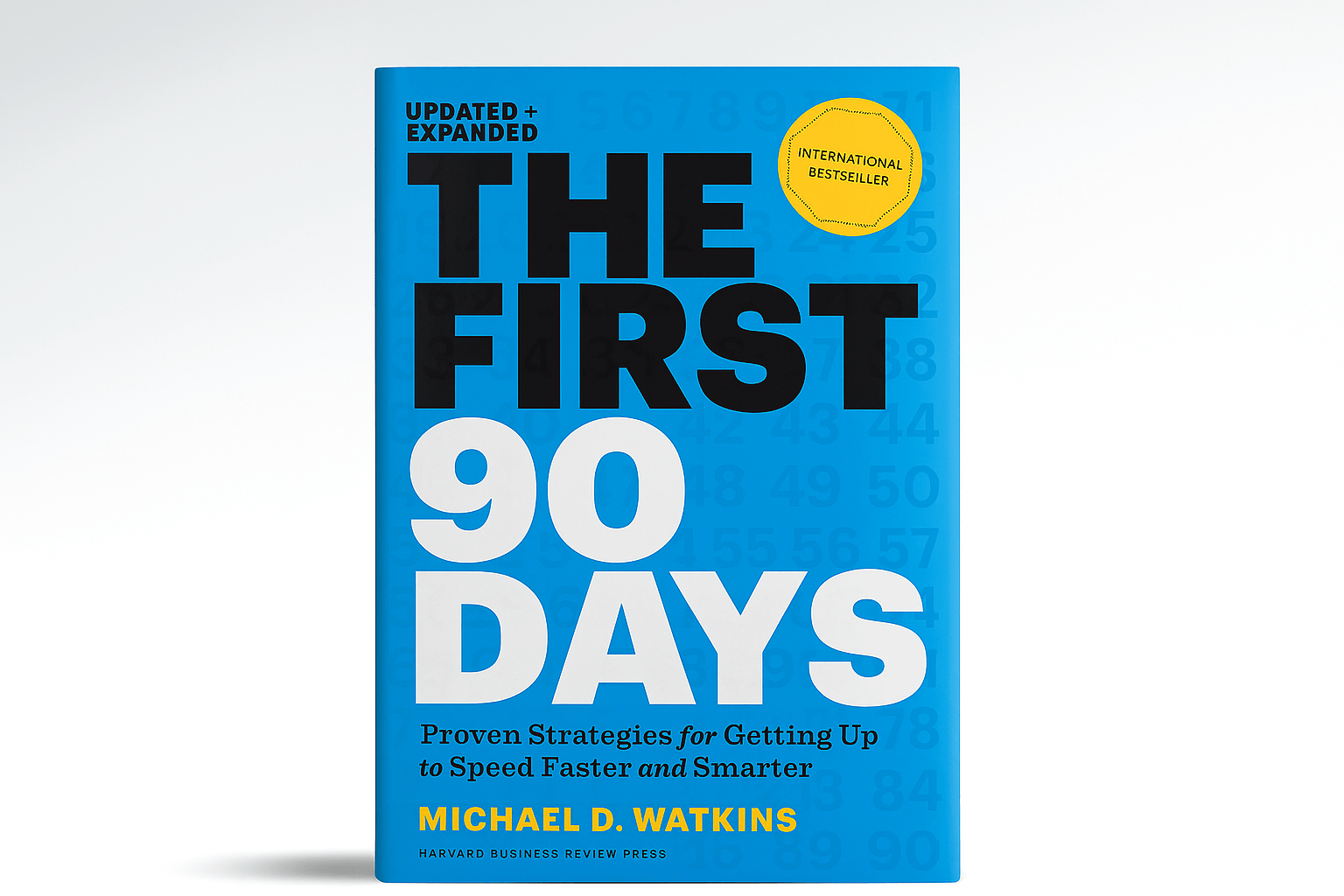The First 90 Days: Proven Strategies for Getting Up to Speed Faster and Smarter by Michael D. Watkins is widely regarded as the definitive manual for navigating leadership transitions. Whether you’re stepping into a new organization or rising to a new role internally, this guide provides a clear framework to get up to speed quickly, build credibility, and lay the groundwork for long-term success. This post summarizes the key concepts from the book and shares a practical review to help you take action.
Key Takeaways
- Prepare in advance by understanding your new environment and role expectations.
- Accelerate your learning to make informed decisions quickly.
- Use the STARS model to assess the business situation and adapt your leadership approach.
- Secure early wins to build credibility and energize your team.
- Align strategy, structure, and processes for long-term impact.
- Build alliances and manage relationships with stakeholders.
- Practice self-management and support others in their transitions.
Chapter-by-Chapter Summary
Chapter 1: Prepare Yourself
Before day one, mentally let go of your previous role and embrace your new responsibilities. Understand the organization’s culture, history, and politics. Clarify expectations with stakeholders and plan how to communicate formally and effectively.
Chapter 2: Accelerate Your Learning
Develop a learning agenda that includes understanding products, markets, processes, and people. Learn from internal experts like frontline workers and external sources like customers and partners. Use structured questions about the past, present, and future.
Chapter 3: Match Strategy to Situation
Use the STARS model: Start-up, Turnaround, Accelerated Growth, Realignment, and Sustaining Success. Each requires a different strategy. Diagnosing your current situation accurately is key to choosing the right leadership approach.
Chapter 4: Negotiate Success
Shape expectations by engaging with your boss early. Plan five types of conversations: situational diagnosis, expectations, resource needs, working styles, and personal development. Clarify priorities, success metrics, and communication preferences.
Chapter 5: Secure Early Wins
Gain credibility by delivering quick, visible results. Understand your existing reputation and focus on building it through successful early initiatives. Avoid trying to fix everything at once; instead, pick impactful projects that align with long-term goals.
Chapter 6: Achieve Alignment
Align vision, structure, core processes, and skills. Identify any mismatches that could hinder performance. Use your leadership to create cohesion across strategic goals, team structure, and operational systems.
Chapter 7: Build Your Team
Evaluate your team members within the first 30 days. Categorize them into keepers, developers, movers, or replacements. Make thoughtful decisions about team structure, responsibilities, and development.
Chapter 8: Create Alliances
You need support from people you don’t directly manage. Identify stakeholders, influencers, and potential allies. Build relationships using consultation, framing, and sequencing strategies. Convert resistance into collaboration when possible.
Chapter 9: Manage Yourself
Transitions are emotionally demanding. Self-awareness, daily discipline, and strong personal routines are critical. Maintain focus on priorities, create space for reflection, and stabilize your home and work environments.
Chapter 10: Accelerate Everyone
Support others through their transitions too. When leaders across an organization transition successfully, collective performance improves. Help your team adapt by sharing strategies, fostering alignment, and removing obstacles.
Review of The First 90 Days
Michael Watkins provides a structured, actionable playbook for new leaders. The clarity of his models and the practical tools he offers—from checklists to diagnostic frameworks—make this book a valuable resource.
Strengths:
- Actionable frameworks and real-world examples
- Emphasis on preparation and early momentum
- Balanced advice on interpersonal and organizational strategy
Limitations:
- Some may find the format too structured
- Requires significant reflection and discipline to implement
This book is best suited for:
- First-time managers and senior leaders
- Professionals navigating high-stakes transitions
- HR leaders developing onboarding programs
FAQs
What is The First 90 Days about?
It is a guide to help new leaders transition smoothly into their roles, focusing on the first three months as the most critical period for long-term success.
Who should read this book?
Newly promoted leaders, executives joining a new organization, and professionals preparing for future leadership roles.
What is the STARS model?
A diagnostic tool to categorize business situations: Start-up, Turnaround, Accelerated Growth, Realignment, and Sustaining Success. It helps leaders tailor their approach.
Why are early wins important?
Early wins build credibility, energize teams, and establish a leader’s presence. They show stakeholders that progress is being made.
What is the main message of the book?
Leadership transitions are vulnerable periods. Success depends on fast learning, relationship-building, strategic planning, and self-discipline.


